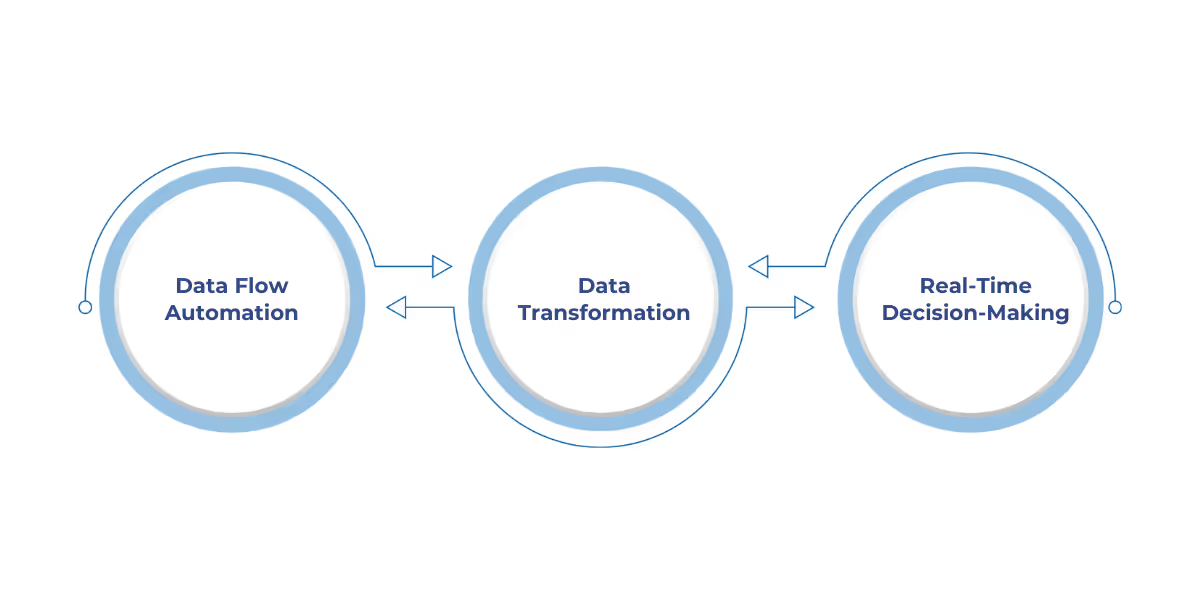

We understand that adopting new automation platforms and integrating complex systems can feel overwhelming and challenging, especially when trying to maintain operational continuity across diverse industries.
Power Automate and Microsoft Fabric provide an integrated platform that enables businesses to streamline operations by automating workflows, integrating systems, and ensuring real-time data movement.
Power Automate is a low-code, cloud-based service designed to automate repetitive tasks and workflows across various Microsoft and third-party systems.
It uses advanced workflow orchestration to connect applications and automate actions based on business rules and events. This reduces manual labor, accelerates decision-making, and ensures seamless data flow between multiple systems.
Below are the main benefits of using Power Automate and Microsoft Fabric together:
Before you can leverage the full potential of Power Automate and Microsoft Fabric together, it’s important to ensure that your Dataverse environment is properly set up

Here are the key prerequisites for linking your Dataverse environment with Microsoft Fabric:
Integration is key to achieving comprehensive automation. Let’s explore how Power Automate and Microsoft Fabric work together to streamline and automate business processes.
Power Automate and Microsoft Fabric provide businesses with the ability to connect various systems and applications, streamlining workflows and eliminating manual interventions.
The integration of these platforms allows for efficient, end-to-end automation, ensuring smooth data flow and reducing the need for human oversight.
Use case: A financial services organization can automate loan applications, from document verification to fund disbursement, integrating CRM, finance, and document management systems for streamlined operations.
Now let's explore how Power Automate’s low-code environment enables businesses to create custom workflows quickly and easily.
Also Read: Financial Reporting in Dynamics 365 Management Reporter
Power Automate’s low-code environment enables users without programming expertise to create custom workflows. This allows business users to automate routine processes quickly, without relying on developers or lengthy development cycles, making automation accessible to a broader range of employees.
Use case: A manufacturing company automates the process of approving production orders.
Once an order is entered into the ERP system, Power Automate can send approval requests to managers, route documents for review, and update the ERP system once approval is granted, all without manual input from staff.
As automation and data flow work together, real-time insights become essential.

Microsoft Fabric automates data movement and transformation, enabling efficient management of large data volumes and providing real-time insights for faster, data-driven decision-making.
1. Data Flow Automation
Fabric integrates diverse data sources such as CRM, ERP, and external APIs into a unified data pipeline using Azure Data Factory. This continuous flow of data across systems ensures real-time access, eliminating manual intervention and improving data consistency.
2. Data Transformation
Fabric utilizes ETL/ELT processes to automatically clean, normalize, and transform raw data into structured formats for analysis. This ensures data is ready for analysis with minimal processing time and removes human errors in data handling.
3. Real-Time Decision-Making
By automating data movement, businesses can access up-to-date data instantly. Fabric’s real-time data processing capabilities, powered by Azure Synapse Analytics, enable faster decisions with live insights and immediate action on emerging trends.
Example: In the utilities sector, Fabric integrates sensor data using real-time streaming analytics to detect equipment anomalies.
This triggers automatic alerts and maintenance actions, minimizing downtime and optimizing operational efficiency without human input.
Power Automate and Microsoft Fabric use AI and machine learning to optimize business processes.
For example, a retail company uses machine learning to predict product demand from historical sales, automatically adjusting stock levels, prices, and promotions in real-time to maximize sales and reduce overstock.
As automation expands, it’s critical to ensure that security and compliance are maintained.
Power Automate and Microsoft Fabric embed robust security features to automate compliance processes, ensuring secure and regulated workflows at scale.

WaferWire Cloud Technologies helps businesses of various sizes and industries streamline workflows, enhance decision-making, and maintain security and compliance with tailored cloud solutions, AI, and data analytics.
Integrating Power Automate with Microsoft Fabric enhances workflow automation, data management, and compliance, driving operational efficiency. By leveraging AI, machine learning, and real-time insights, businesses can automate manual tasks and make data-driven decisions more efficiently.
At WaferWire, our cloud and AI experts can guide you through the entire process of integrating Power Automate and Microsoft Fabric, from initial setup to advanced customization.
Contact WaferWire today to get the full potential of automation and scale your operations efficiently.
Q: Can Power Automate integrate with non-Microsoft applications?
A: Yes, Power Automate supports integration with numerous third-party applications such as Salesforce, SAP, Google services, and more, enabling automation across a wide range of platforms.
Q: How do Power Automate and Microsoft Fabric handle data privacy and compliance?
A: Both tools are built with robust security features, including data encryption, access controls, and compliance with various industry regulations (such as GDPR and HIPAA), ensuring that data privacy is maintained throughout automation processes.
Q: Is Power Automate suitable for businesses with limited technical expertise?
A: Yes, Power Automate’s low-code platform allows business users without technical skills to create custom workflows, making automation accessible to a wider audience across the organization.
Q: Can Microsoft Fabric be used for predictive maintenance in manufacturing?
A: Yes, Microsoft Fabric can collect and analyze data from manufacturing equipment in real-time, using machine learning models to predict maintenance needs and reduce unplanned downtime.
Q: What industries benefit most from Power Automate and Microsoft Fabric integration?
A: Industries such as retail, financial services, manufacturing, and utilities benefit the most, as they require real-time data processing, automation of complex workflows, and streamlined operations across multiple systems.

